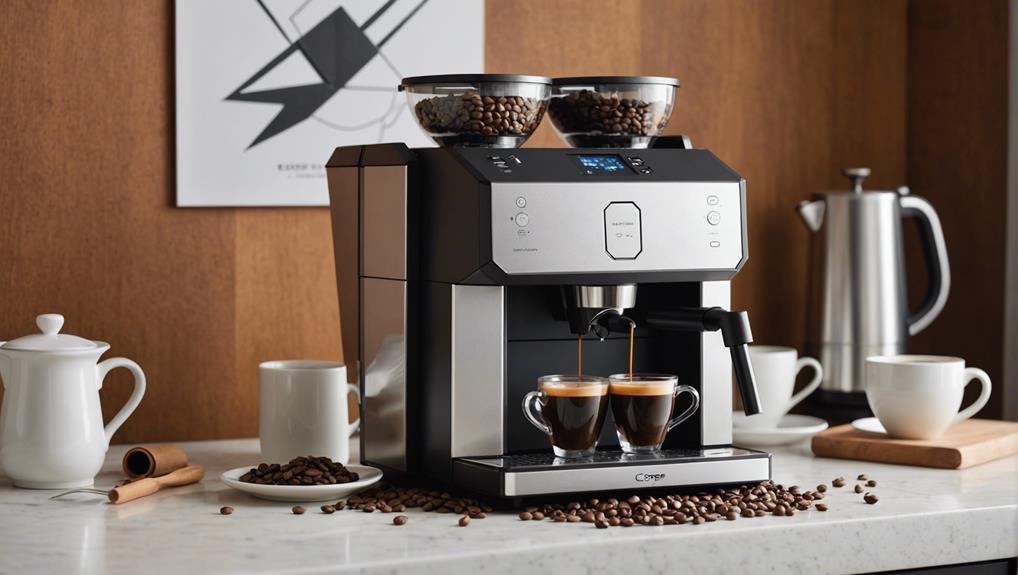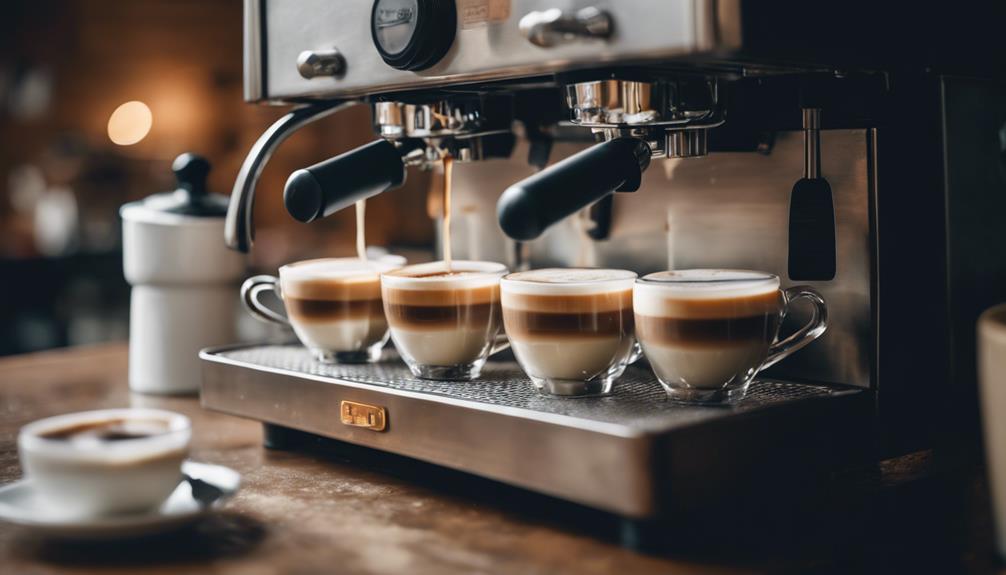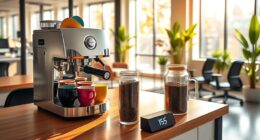In espresso roast, darkness is a key indicator of a rich variety of flavors resulting from prolonged roasting. This process enhances caramelization, smokiness, and richness, leading to a bold and strong flavor profile that is ideal for espresso shots. The dark hue and oils drawn out during roasting produce a distinctive depth and complexity that distinguishes this particular roast. Embrace the balanced fusion of bitter richness and sweet notes that define the darkness in espresso roast. Delving deeper into the experience exposes a world of vigorous and varied flavors just waiting to be explored.
Key Takeaways
- Dark espresso roast features a longer roasting process for rich flavors.
- Characterized by bold and robust taste with caramel, chocolate, and nutty notes.
- High in intensity, bitterness balanced with richness, and low acidity.
- Oils from extended roasting contribute to a dark color and intense flavor.
- Caramelization during roasting enhances smoky and bold taste profile.
Characteristics of Espresso Roast
Espresso roast, tailored specifically for creating intense espresso shots, is characterized by a medium to dark roast level that enhances richness, sweetness, and acidity in the coffee. This particular roast is ideal for extracting the concentrated flavors needed in espresso-based drinks.
The dark roast of espresso beans contributes to a flavor profile that includes a chocolatey body with subtle notes of red berry sweetness, providing a well-rounded taste experience. When brewed under high pressure in espresso machines, the finely ground espresso roast reveals its full potential, resulting in a robust and flavorful shot of espresso.
The balance achieved in espresso roast between richness, sweetness, and acidity guarantees that the flavors remain prominent even when mixed with other ingredients in popular espresso-based beverages like lattes or cappuccinos. Understanding the characteristics of espresso roast is essential for coffee enthusiasts looking to appreciate the nuances of a well-crafted espresso shot.
Flavor Profile of Dark Roasts

Dark roasts boast a bold and robust flavor profile, characterized by a balance of bitterness and richness.
These roasts often feature notes of caramel, chocolate, and nuttiness, creating a deep and intense taste experience.
The extended roasting process at high temperatures leads to the development of a darker color and oils on the surface, enhancing the complex flavors of dark roasts.
Bold and Robust Flavors
Within dark roasts, the bold and robust flavors stand out prominently, offering a distinctive taste experience that captivates coffee enthusiasts.
Dark roasts, characterized by their intense profile, are known for their bold flavors that are perfect for espresso shots. These roasts are roasted at higher temperatures for a longer duration, resulting in a darker color and oils that contribute to their rich taste.
One of the key processes that occurs during the longer roasting of dark roasts is caramelization, where sugars in the beans caramelize, adding depth and complexity to the flavor profile.
Common tasting notes found in dark roasts include caramel, chocolate, and nutty flavors, enhancing the overall richness of the brew.
Due to their robust and balanced flavors, dark roasts are favored for espresso, providing a satisfying and full-bodied coffee experience that many coffee lovers seek.
Bitterness Balanced With Richness
When roasting coffee beans to create dark roasts, the bitterness is carefully balanced with richness to achieve a distinctive flavor profile. Dark roasted coffee offers a bold and smoky taste, characterized by low acidity and hints of caramel, chocolate, and nuts. The art of dark roasting lies in the process of caramelization, where sugars in the beans are transformed, enhancing the depth of flavor. This caramelization not only brings out sweetness but also helps in balancing the inherent bitterness of dark roasts.
To further understand the interplay between bitterness and richness in dark roasted coffee, let's explore the following table:
| Aspect | Description |
|---|---|
| Bitterness | Initial sharp taste that mellows out, providing a robust undertone to the overall flavor profile. |
| Richness | Deep, full-bodied sensation on the palate, often accompanied by notes of caramel and chocolate. |
| Caramelization | Process that intensifies sweetness while adding complexity, contributing to the richness. |
| Flavor Profile | Smoky, bold, and well-rounded with a satisfying mix of caramel, chocolate, and nutty notes. |
Dark roasts, known for their intensity and versatility, are favored in espresso brewing for the rich and fulfilling coffee experience they deliver.
Roasting Process for Dark Espresso

When roasting dark espresso beans, the process involves longer times at high temperatures to achieve a deep, rich flavor.
This extended roasting leads to the extraction of oils on the beans' surface, enhancing the aroma and intensity of the coffee.
The result is an espresso with an intense flavor profile and a robust, smoky taste that sets it apart from lighter roasts.
Intense Flavor Development
To achieve intense flavor development in dark espresso roasts, the roasting process involves subjecting the beans to high temperatures for an extended duration. This extended roasting time results in a darker color of the beans and the formation of oils on the surface, enhancing the richness of the coffee. The caramelization of sugars during this process contributes greatly to the bold and smoky flavor profile characteristic of dark espresso roasts. These intense flavors are what make dark espresso roasts ideal for the espresso brewing method, as they create concentrated and balanced espresso shots. The lower acidity levels in dark espresso roasts also add to their appeal, providing a robust and full-bodied coffee experience. Below is a table summarizing the key points related to the intense flavor development in dark espresso roast:
| Aspect | Description |
|---|---|
| Roasting Temperature | High temperatures are applied for an extended duration to develop intense flavors. |
| Oil Formation | Extended roasting leads to oils on the beans, enhancing richness. |
| Flavor Profile | Caramelization of sugars contributes to bold and smoky flavors. |
| Ideal for Espresso | Dark roasts create balanced espresso shots with concentrated flavors. |
Rich Aroma Extraction
During the roasting process for dark espresso, the extraction of rich aromas is an indispensable aspect that enhances the overall coffee experience.
Dark espresso roast involves subjecting the beans to high temperatures for an extended period, leading to the development of oils on the surface of the beans. These oily beans contribute to a fuller body and a more pronounced aroma in the final cup of espresso.
The roasting process for dark espresso roast is pivotal in achieving a bolder and more intense flavor profile. As the beans reach a darker color during roasting, the caramelization of sugars within them imparts robust and smoky notes to the coffee.
This richness in aroma extraction is what sets dark espresso roast apart, making it ideal for those who enjoy a strong and flavorful coffee, especially in espresso-based drinks like lattes and cappuccinos.
Brewing Techniques for Dark Espresso

Properly brewing dark espresso involves adjusting brewing temperatures to extract ideal flavors while avoiding bitterness.
For dark espresso roasts, a coarser grind size is recommended to prevent over-extraction, ensuring a balanced and rich taste.
Experimenting with different espresso blends, brewing methods, and brew ratios can help you find the perfect combination for your preferred flavor profile.
When brewing dark espresso, longer extraction times might be necessary to fully reveal the bold flavors inherent in these roasts.
Remember to store your dark espresso beans in an airtight container, shielded from light and heat, to maintain their freshness and quality.
By paying attention to details like water quality, temperature, and bean type, you can fine-tune your brewing techniques to achieve the desired intensity and depth in your dark espresso shots.
Experimentation and attention to detail are key to mastering the art of brewing dark espresso.
Acidity Levels in Dark Roasts

Adjusting brewing techniques for dark espresso roasts involves understanding the low acidity levels characteristic of these intense and robust flavors. Dark roasts are known for their mellowed-out acidity, resulting in a smoother flavor profile that emphasizes bold and rich tastes over tanginess. To highlight the differences in acidity levels between dark roasts and lighter roasts, refer to the table below:
| Aspect | Dark Roasts |
|---|---|
| Acidity Level | Low |
| Flavor Profile | Intense, robust |
| Acidity Impact | Mellowed-out |
| Taste Notes | Bold, smoky |
| Body | Full-bodied |
In dark roasts, the longer roasting process caramelizes sugars and oils in the beans, contributing to their deep color and intense flavors. This results in acidity being secondary to the pronounced bitterness and smoky notes that are characteristic of dark espresso roasts.
Caffeine Content in Espresso Roast

When considering the caffeine content in espresso roast coffee, it's essential to recognize that the intensity of the flavors and concentration, rather than the roast level itself, often influences the perception of higher caffeine levels.
Here are some key points to understand about caffeine content in espresso roast:
- Espresso roast doesn't inherently contain more caffeine: The primary factors influencing caffeine content are the bean origin and brewing method.
- Perception vs. reality: The perception of higher caffeine in dark roasts like espresso is due to intense flavors, not necessarily higher caffeine content.
- Brewing process matters: When brewed as espresso, these beans may have a slightly higher caffeine concentration per ounce compared to drip coffee due to the extraction method.
- Variability: The caffeine content in espresso roast can vary based on factors like bean origin, roast level, and extraction method utilized.
Understanding these nuances is important for managing your caffeine intake when indulging in espresso roast coffee.
Tips for Perfect Dark Espresso

For achieving a perfect dark espresso, consider adjusting the brewing temperature and experimenting with different grind sizes to enhance the bold flavors.
Dark espresso roasts, known for their intense profiles, require ideal brewing temperatures to prevent bitterness. Ideal temperatures help extract the rich flavors without overpowering the taste.
When grinding beans for dark espresso, opt for coarser sizes to avoid over-extraction, which can lead to a harsh brew. These coarser grinds allow for a balanced extraction, highlighting notes of caramel, chocolate, and nutty undertones inherent in dark espresso roasts.
To further refine your dark espresso experience, try experimenting with variables such as water quality and brewing time. By playing around with these factors, you can fine-tune the taste to suit your preferences, creating a perfect cup of dark espresso that embodies the bold and robust characteristics of this distinct roast.
Pairing Dark Espresso With Food

Pair dark espresso with a variety of dishes to enhance and complement the bold flavors of this intense roast. When considering food pairings for your dark espresso, here are some suggestions to elevate your dining experience:
- Rich and Decadent Desserts: Indulge in the intense flavors of dark espresso alongside rich treats like chocolate cake or tiramisu for a harmonious combination of bitterness and sweetness.
- Grilled Steak and Savory Dishes: The robust and bold profile of dark espresso pairs exceptionally well with savory dishes such as grilled steak or roasted lamb, enhancing the overall dining experience.
- Spicy Foods: Contrasting with the heat of spicy dishes like chili or curry, dark espresso adds depth and complexity to the meal, creating a tantalizing fusion of flavors.
- Creamy Delights: Creamy dishes like cheesecake or creamy pasta dishes are elevated by the bitterness of dark espresso, providing a perfect balance of flavors for a satisfying dining experience.
Frequently Asked Questions
What Does Dark Roast Espresso Mean?
Dark roast espresso means coffee beans roasted longer and at higher temperatures, resulting in a rich, intense flavor. The extended roasting process brings out oils on the beans, leading to a darker appearance and deeper taste.
This type of espresso is bold with smoky notes, low acidity, and a complex depth from caramelized sugars. It's favored for its robust coffee experience and is commonly used in espresso machines for concentrated shots.
What Is the Darkness of Coffee?
The darkness of coffee refers to the level of roasting, influencing flavor and aroma.
Dark roasts have longer roasting times, resulting in bold, smoky tastes and oils on the beans. Roasting caramelizes sugars and brings out oils, impacting the brew's intensity and richness.
Dark roasts often feature notes of caramel, chocolate, and nuts due to extended roasting. This darkness is popular for espresso preparation, creating a robust and flavorful cup.
What Defines an Espresso Roast?
To define an espresso roast, it's all about the darkness level achieved through longer roasting times. This brings out intense flavors like chocolatey richness and red berry sweetness. The focus is on extracting bold and complex tastes, ideal for espresso brewing.
With a fine grind optimizing extraction, espresso roasts are tailored for high-pressure machines. The darkness in espresso roasts contributes greatly to their distinctive flavor profile, setting them apart in the world of coffee.
What Is the Difference Between Dark and Light Roast Espresso Grind?
The difference between dark and light roast espresso grind lies in the grind size. For dark roast, the grind is coarser to prevent bitterness and allow for balanced extraction of bold flavors.
On the other hand, light roast espresso grind is finer to enhance flavor extraction and acidity, bringing out the brightness and complexity of the coffee.
The contrast in grind size directly impacts the overall taste and aroma of the espresso.
Does the Darkness of Espresso Roast Contribute to its Bitterness?
Yes, the darkness of espresso roast can contribute to its bitterness. The longer roasting process brings out the natural oils in the coffee beans, which can lead to a more intense and bitter flavor. This is one factor in understanding how espresso becomes bitter.
How Does the Color of Espresso Roast Affect the Darkness of the Coffee?
The color of espresso roast is crucial in determining the darkness of the coffee. The longer the beans are roasted, the darker the color, resulting in a more intense and robust flavor. Different levels of roasting define espresso color and impact the final taste and aroma of the coffee.
Conclusion
To sum up, the darkness of espresso roast is defined by its rich flavor profile, bold aroma, and deep color.
When brewing dark espresso, attention to the roasting process and acidity levels is essential for a perfect cup.
Remember to experiment with different brewing techniques and pairings to enhance your espresso experience.
So, next time you reach for a dark roast, savor the complexity and intensity it brings to your morning routine.
Enjoy your coffee journey!









